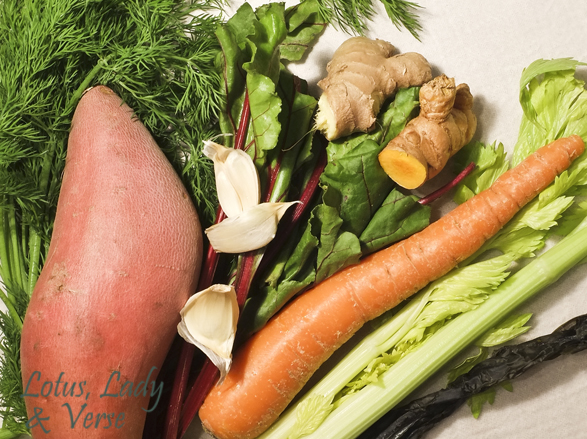Mirepoix—carrots, celery and onions— a classic combo for Broth, as in Vegetable Broth: Homemade and Delicious!
Make Broth n’ Ginger Tea for a warming drink. See the recipe on this blog.

If Mirepoix is added to the cooking liquid, the taste of the broth is exceptionally good.
I had always refused to make broth. It sounded elusive—that delicate flavor with rich undertones—how could I achieve it with my not well-known level of culinary ability?
But as I found out, through trial and error*, it’s just not that difficult to make, even with a beginner’s culinary skills! And with Mirepoix, a French word that refers to taste in cooking, you can brew this wonderful broth, fresh, in your kitchen. And then it becomes a canvas for the addition of herbs and spices, and can be especially warming and medicinal.
All you need to start is— you guessed it, vegetables you may already have in your fridge.
Ingredients:For approximately 6 cups of broth, gather the following:
Sulfurous vegetables: 1 medium onion or 3 whole scallions; 6-10 garlic cloves
Root vegetables: 1 or 2 carrot sticks, ½ baking potato, ½ sweet potato—these with skins on
Fibrous vegetables: 3-4 ribs of celery or ½ celery root or both
Leafy greens: a good fist full of beet greens, swiss chard, collard greens, or kale
Herbs and Spices: parsley, dill or coriander; dried bay leaf; fresh ginger, fresh turmeric
Vegetable scraps: onion skins, broccoli stems, or the heart of a cauliflower or cabbage, veins of kale or collard greens, tops and bottoms or peels from carrots, potatoes, stems from parsley or coriander, that you would normally throw out, but have kept expressly to make broth.
Cruciferous vegetables: not necessary for broth!*
Cut vegetables into large chunks or cut them in half to expose their interior goodness. Garlic cloves don’t have to be removed, but with fresh ginger, fresh turmeric if available, these should be skinned. Add sea vegetables for broth depth and vitamins.
Place all the ingredients in a large deep pot on your stove and tamp down. You need a bit of air-pocket above the cooking broth for steam to gather and drip back into the liquid. Pour plain, filtered water into the pot, almost covering everything, place the lid on and turn the heat to medium-high. You want to boil the vegetables, but not at a rollicking boil, which might evaporate too much water. Once the water and vegetables have reached their maximum heat, turn the heat down to a slow boil and allow to cook for at least one to one-and-a half hours.
Once the cooking process is complete, vegetables will appear spent, and if you poke them with a fork, they are too soft to pick up in one piece. The broth liquid will be a soft bronze or rosey color, depending on the vegetables chosen.
At that point, you can add herbs and spices and condiments such as Himalyan Pink Salt or Celtic Salt, freshly ground pepper. It’s a neat trick that intensifies flavor. Ground turmeric and spices and dried herbs can refine the flavors even more. Stir, and keeping the lid on the pot, leave everything in place on the stove for another 1-2 hours. The herbs and spices are steeping in the broth, making it taste even richer.
Finally, when the broth has cooled, strain out the spent vegetables and discard them. Decant your broth into glass jars, screw on the lids and store in the fridge for up to 3-4 days. You can also freeze your broth for up to one month—by why wait? Experience the great taste now in all kinds of ways.
Make Broth n’ Ginger Tea for a warming drink. See the recipe on this blog. *When learning the ways of broth…… one of the first mistakes I made was to purchase special vegetables for my broth—I didn’t realize that an everyday mixture of vegetables and vegetable scraps tastes best. And typically, carrots and celery are the backbone of a broth, as are onions. Voila, with carrots, celery and onions you have a basic mirepoix, a classic flavor combination that contributes to a rich broth taste.
Next I found that too many of one kind of vegetable makes for a forgettable broth—certain bitter vegetables are in this category, along with too many onion skins!
And thirdly, too much water, like covering the cut vegetables with 2 inches of water, really steals flavor away from a broth.
Do you have a recipe fave for broth? Write to me using the Contact page. I’d love to hear about your ideas and selection of which vegetables work best for you.
Follow



[…] a chilled-to-the-bone body to do? But for the mineral-rich broth brewed last night from vegetable trimmings and scraps, potato wedges, sweet potato, carrots, […]